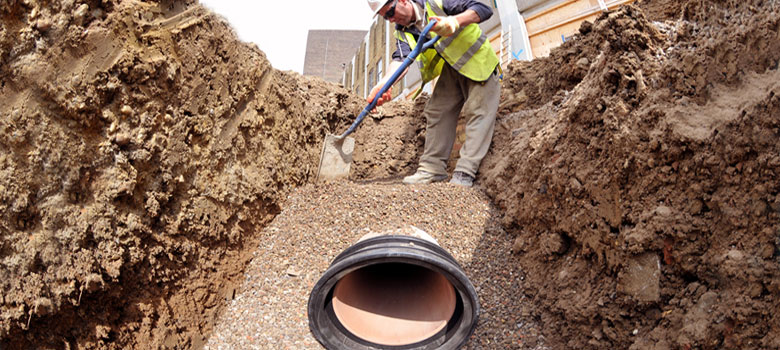Bedding down

The bedding surround for any pipe is critical to support its load bearing capacity. For adoptable drainage bedding surrounds are split in to two categories; flexible and rigid pipes.
A clay pipe system is classed as a rigid pipe system which comes with significant advantages in its load bearing capacity and potential to use as dug materials for back fill.
For clay pipe systems trench beddings are classified in to a class, with each ‘class’ having a differing effect on the load bearing capability of the pipe. The bedding classes range from pipes been laid on a trimmed as dug base and covered with as dug material up to a full concrete surround. In between these, classes include for pipes laid on a granular bed and covered with as dug material, pipes with a full granular bed and surround and pipes with a part bed and surround.
Each bedding type has a factor, which is the enhancement that bedding type has on the pipes crushing strength. For example a pipe with a crushing strength of 40kN/m with a pipe bedding factor of 1.1 will have a designed crushing strength of 44 kN/m. The same 40 kN/m pipe with a bedding factor of 2.5 will have a designed crushing strength of 100 kN/m.
The types of trench beddings for each pipe diameter and the applications and depths each can be used in is detailed in the design section of the Clay Pipe Development Association website. See – Structural Design of Clay Pipes | CPDA. This demonstrates that a DN150 clay pipe with a crush strength of 40 kN/m can be used with as dug bedding material under main traffic roads from 0.6 to 5.6 metres depth.
This gives a potential significant reduction in the use of scarce and expensive aggregates and can minimise truck movements to and from site as there is no need to bring in aggregates or have as dug material removed from site.
As can be seen in the bedding factors for each class the use of aggregates for the bedding will only further enhance the crushing strength of the pipe, which will in turn ensure its continued longevity in case of future significant increases in loads. Where aggregates will be used in clay pipe bedding the use of recycled aggregates is permitted which can reduce cost and the environmental impact.
In all projects the bedding needs to take in to account the relevant design considerations such as potential loading and site conditions such as soil conditions and water table levels. For adoptable drainage the materials used, design and installation should be in conjunction with the latest guidance for the country of installation. For up to date versions of the latest guidance see the Legislation and Standards section of the Clay Pipe Development Association website – Sewers for Adoption – CPDA.
Further guidance can be found on the Water UK website – We bring people together to create better policies for the future of water | Water UK. This includes the following documents:
WIS 4-08-02 SPECIFICATION FOR BEDDING AND SIDEFILL MATERIALS FOR BURIED PIPELINES – WIS 4-08-02 (water.org.uk)
IGN 4-11-02 REVISED BEDDING FACTORS FOR VITRIFIED CLAY DRAINS AND SEWERS – IGN 4-11-02 (water.org.uk)
IGN 4-08-01 BEDDING AND SIDEFILL MATERIALS FOR BURIED PIPELINES – IGN 4-08-01 February 1994 Issue 4 (1).pdf
In addition to the above documents the European Standard BS EN 1610:2015 Construction and Testing of Drains and Sewers gives further information on the requirements for construction of trenches for laying pipes and bedding materials.
In summary the inherent benefits of the high strength of clay pipes can have significant benefits on the selection and use of bedding materials as follows:
- Potential to use as dug material while maintaining high strength characteristics.
- Use of aggregates can further increase the strength of clay pipes
- Using as dug material can bring significant cost and environmental benefits.
- Recycled aggregates can be used for clay pipe bedding material.
Stuart Steel, Product Manager for CPDA member Wavin further commented ‘Clay pipe systems have numerous benefits including longevity of service and high water jetting pressure resistance. The potential to achieve reduced costs and environmental impact by using less or recycled bedding materials further enhances clay as the drainage material of choice’.
